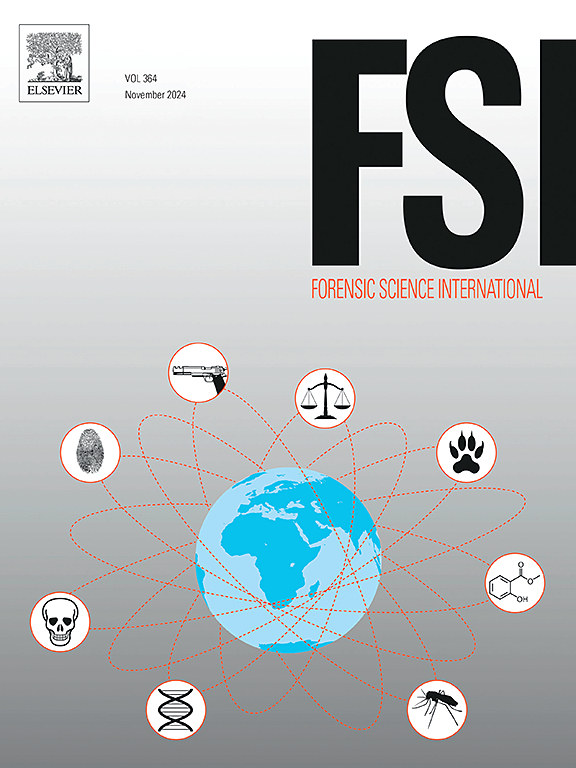Unmanned aerial vehicle (UAV) paired with LiDAR sensor to detect bodies on surface under vegetation cover: Preliminary test
IF 2.2
3区 医学
Q1 MEDICINE, LEGAL
引用次数: 0
Abstract
The use of unmanned aerial vehicles (UAVs) has become increasingly accessible, enabling their deployment in a diverse range of operational contexts. UAVs have been tested as part of search and rescue missions. Following the successful use of UAVs in the wilderness medicine literature, we questioned their ability to be used in forensic context to search for missing persons or human remains, especially under canopy cover. Subsequently, various sensors were then repurposed from their original applications to address forensic concerns. This preliminary study aimed to evaluate the efficacy of airborne Light Detection and Ranging sensors (LiDAR) in detecting a concealed human body on a surface within a densely vegetated search area. To proceed, two LiDAR sensors were tested with several modalities. A dendrometric method was used to estimate the tree density of the search area, and the Normalized Difference Vegetation Index (NDVI) was used to bring precision in the appreciation of canopy cover density. The results showed that airborne LiDAR sensors can capture body signatures in areas with dense vegetation. The ground point density reached 0.26 % in a high-vegetated area. The study highlighted the importance of refining data processing techniques, including point cloud selection and the implementation of true positive/false positive analysis, to improve detection accuracy. Furthermore, the potential integration of complementary sensors such as thermographic and multispectral sensors was discussed, which may enhance the detection of thermal anomalies and chemical markers associated with decomposition.
无人机(UAV)与激光雷达传感器配对,探测植被覆盖下的地表尸体:初步测试
无人驾驶飞行器(uav)的使用越来越容易获得,使其能够在各种作战环境中部署。作为搜索和救援任务的一部分,无人机已经进行了测试。在荒野医学文献中成功使用无人机之后,我们质疑它们在法医环境中用于搜索失踪人员或人类遗骸的能力,特别是在树冠覆盖下。随后,各种传感器从其原始应用中重新定位,以解决法医问题。这项初步研究旨在评估机载光探测和测距传感器(LiDAR)在茂密植被搜索区域内探测表面上隐藏人体的功效。接下来,两个激光雷达传感器进行了几种模式的测试。利用树木学方法估算搜索区域的树木密度,并利用归一化植被指数(NDVI)提高树冠覆盖密度的估算精度。结果表明,机载激光雷达传感器可以在植被茂密的地区捕获人体特征。高植被地区地点密度达到0.26 %。该研究强调了改进数据处理技术的重要性,包括点云选择和真阳性/假阳性分析的实施,以提高检测精度。此外,还讨论了热成像和多光谱传感器等互补传感器的潜在集成,这可能会增强对热异常和与分解相关的化学标记的检测。
本文章由计算机程序翻译,如有差异,请以英文原文为准。
求助全文
约1分钟内获得全文
求助全文
来源期刊

Forensic science international
医学-医学:法
CiteScore
5.00
自引率
9.10%
发文量
285
审稿时长
49 days
期刊介绍:
Forensic Science International is the flagship journal in the prestigious Forensic Science International family, publishing the most innovative, cutting-edge, and influential contributions across the forensic sciences. Fields include: forensic pathology and histochemistry, chemistry, biochemistry and toxicology, biology, serology, odontology, psychiatry, anthropology, digital forensics, the physical sciences, firearms, and document examination, as well as investigations of value to public health in its broadest sense, and the important marginal area where science and medicine interact with the law.
The journal publishes:
Case Reports
Commentaries
Letters to the Editor
Original Research Papers (Regular Papers)
Rapid Communications
Review Articles
Technical Notes.
 求助内容:
求助内容: 应助结果提醒方式:
应助结果提醒方式:


